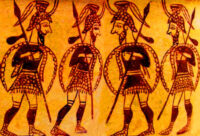 A Resource Historical perspective which explores past and present knowledge to make a case whether Pellana was a major administrative centre or merely a norther frontier town of ancient Lacedaemon. This resource of knowledge, presents a comprehensive exploration of Pellana, a historically significant site in the context of ancient Lacedaemon (Laconia), Greece. The document is dedicated to my family and aims to synthesize various strands of historical, archaeological, and cultural narratives surrounding Pellana, with a particular focus on its role during the Mycenaean period and subsequent historical eras. A copy of the complete EBook may be downloaded via the link: PELLANA – ENGLISH
A Resource Historical perspective which explores past and present knowledge to make a case whether Pellana was a major administrative centre or merely a norther frontier town of ancient Lacedaemon. This resource of knowledge, presents a comprehensive exploration of Pellana, a historically significant site in the context of ancient Lacedaemon (Laconia), Greece. The document is dedicated to my family and aims to synthesize various strands of historical, archaeological, and cultural narratives surrounding Pellana, with a particular focus on its role during the Mycenaean period and subsequent historical eras. A copy of the complete EBook may be downloaded via the link: PELLANA – ENGLISH
The document is structured into several parts, beginning with an introduction that sets the tone for an ongoing debate about Pellana’s potential identification as the palace of Menelaus and Helen, as mentioned in Homeric texts. It emphasizes the importance of interdisciplinary approaches, integrating mythological sources, archaeological evidence, and historical accounts, while acknowledging the limitations of existing scholarly interpretations.
Part One discusses Pellana’s administrative significance in ancient Lacedaemon, presenting arguments for its role as a possible administrative center during the Mycenaean period. The strategic location of Pellana along the Eurotas River and its archaeological findings, including tholos tombs and Cyclopean walls, suggest its prominence in regional governance and trade.
Part Two delves into archaeological discoveries at Pellana, showcasing evidence of Mycenaean habitation and cultural richness. Key findings, such as monumental tombs and artifacts, support the hypothesis of Pellana as a significant settlement during the Bronze Age.
Part Three examines the mythological connections of Pellana to figures like Menelaus and Helen, exploring how these associations enhance the site’s historical narrative. The document engages with the ongoing discourse regarding the identification of Homeric Lacedaemon and the implications of Pellana’s archaeological evidence for understanding Greek mythology.
Part Four highlights the archaeological and historical insights derived from the findings at Pellana, emphasizing its role in the broader context of Mycenaean civilization and its contributions to Greek culture.
Part Five explores the geographical and historical significance of Pellana, detailing how its strategic location and agricultural potential shaped its development as a crucial settlement in ancient Greece.
Part Six addresses contributing factors to the collapse of Mycenaean society, examining how natural disasters, warfare, and societal struggles played a role in the decline of Pellana and other Mycenaean centres.
Part Seven reflects on the decline of Pellana as an administrative hub, linking it to the broader collapse of the Mycenaean civilization and the rise of Sparta.
Part Eight draws’ connections between archaeological findings and mythological narratives, arguing for Pellana’s importance in understanding the interplay between history and legend in Greek culture.
Part Nine discusses Pellana’s post-classical period, assessing its historical trajectory from a significant Mycenaean center to a lesser-known village under various ruling powers, including the Romans and Ottomans.
Part Ten focuses on the accounts of ancient travellers who documented Pellana, reinforcing its historical significance through their observations.
It calls for further research and preservation efforts to uncover the rich history of Pellana, recognizing its potential as a vital site for understanding the complexities of ancient Greek civilization. Through a synthesis of various sources, my aim is to contribute to the ongoing discourse surrounding Pellana’s historical identity while celebrating its cultural legacy. The document serves as a living resource for scholars, educators, and enthusiasts of Greek history, underscoring the importance of community engagement in preserving and promoting local heritage.
